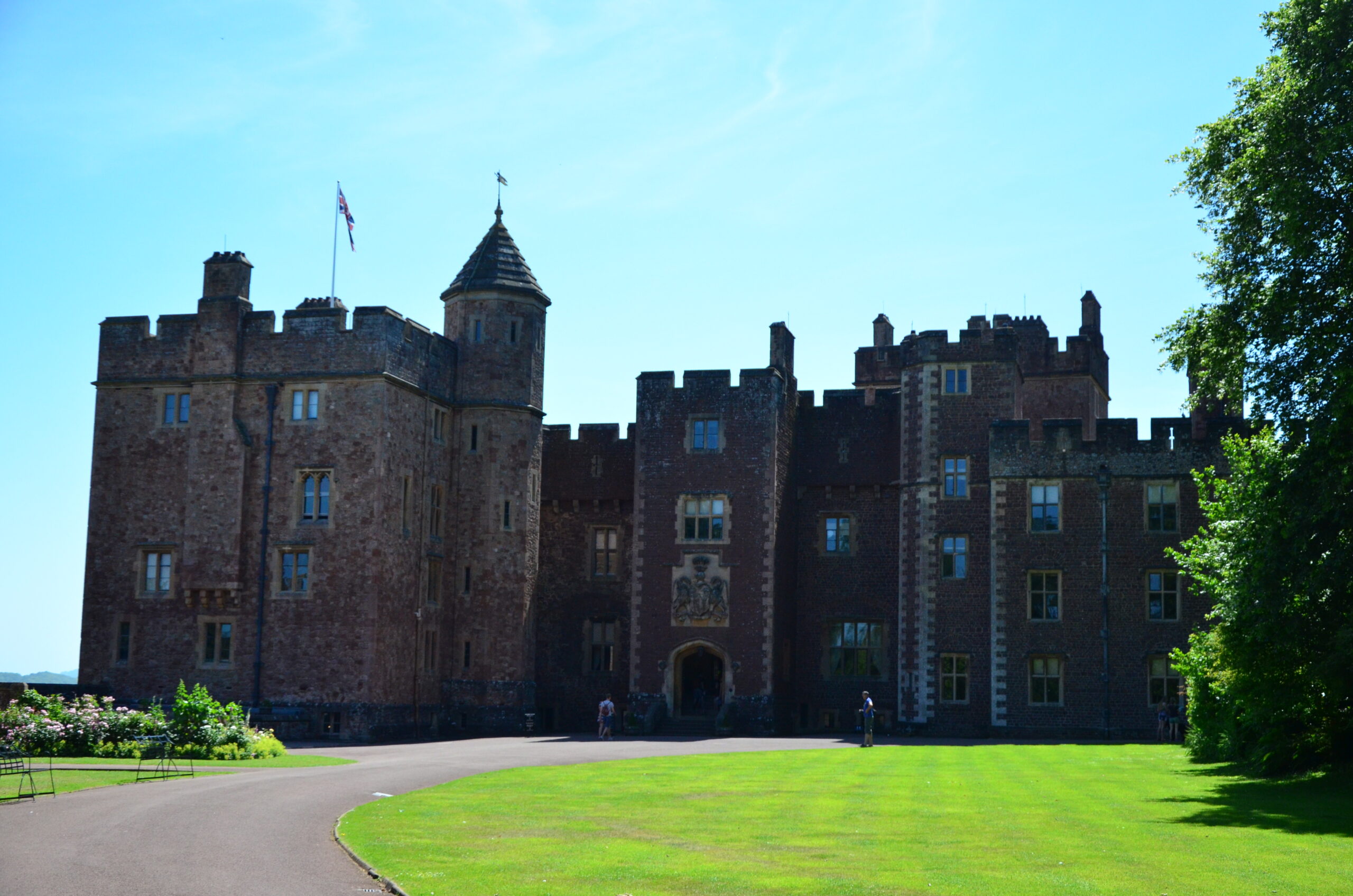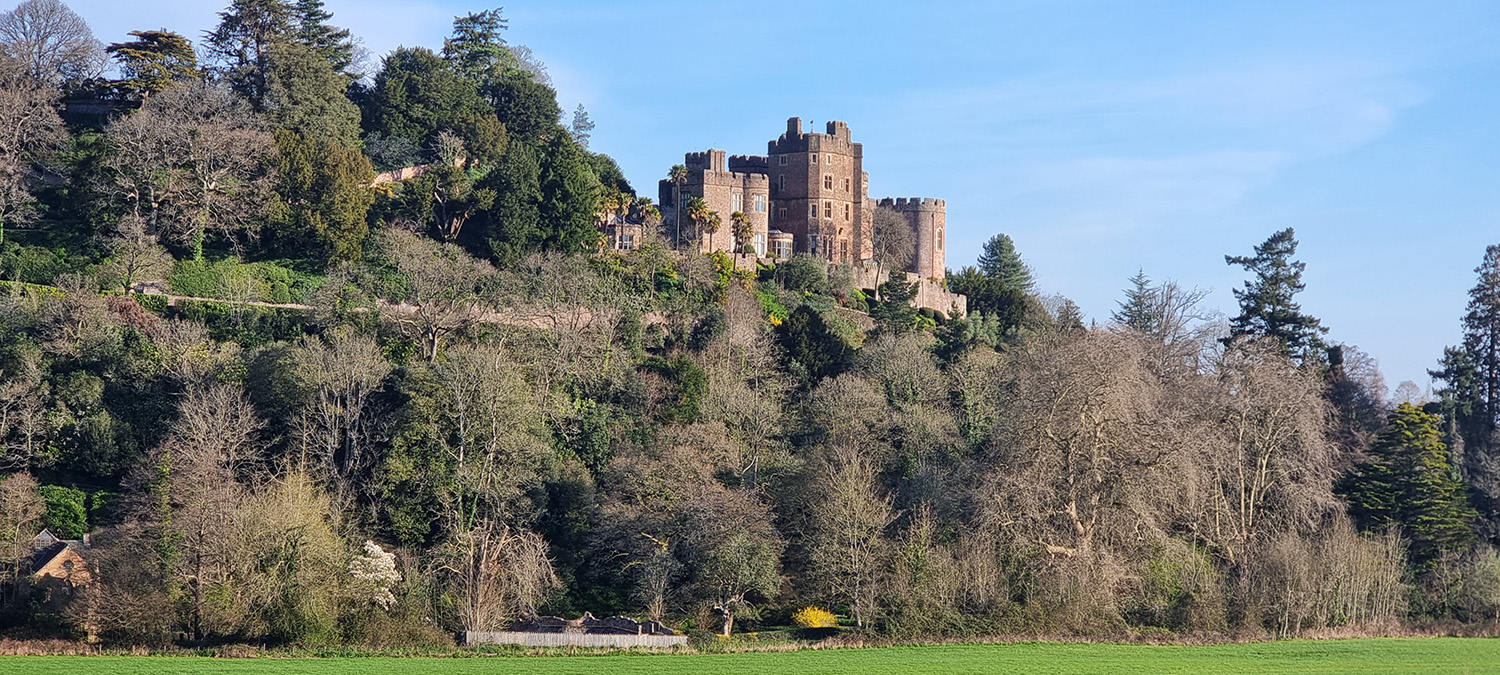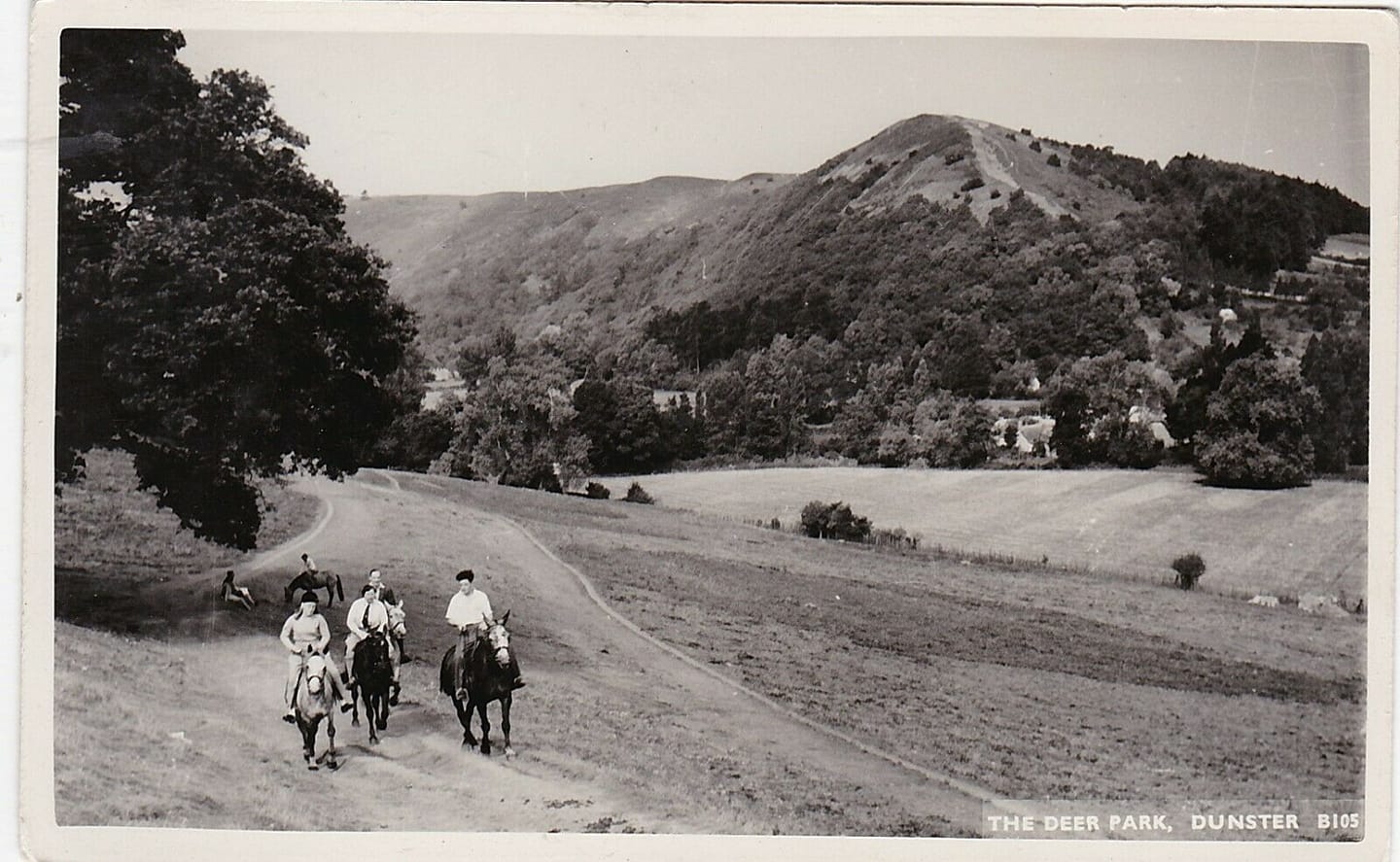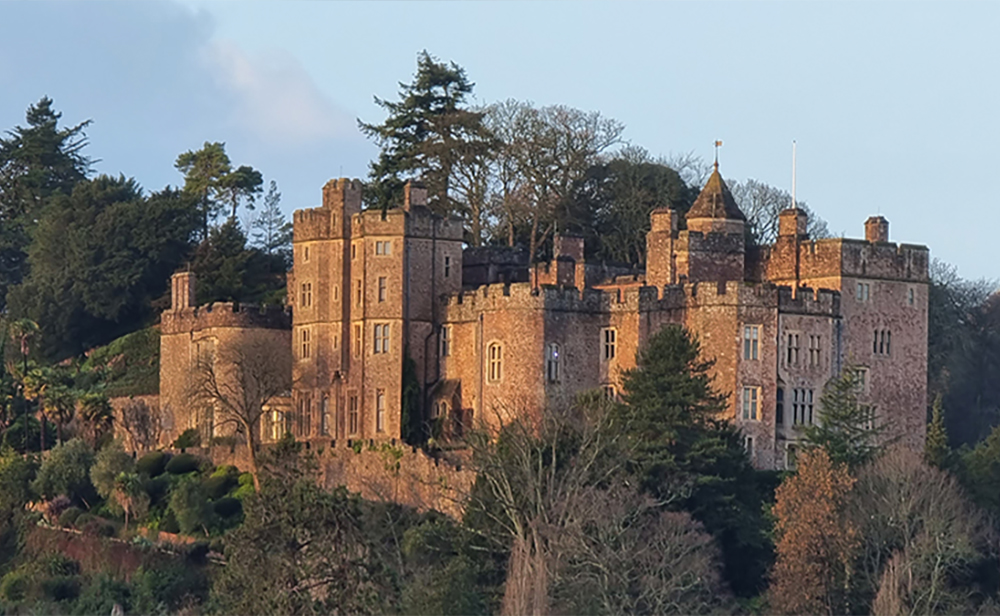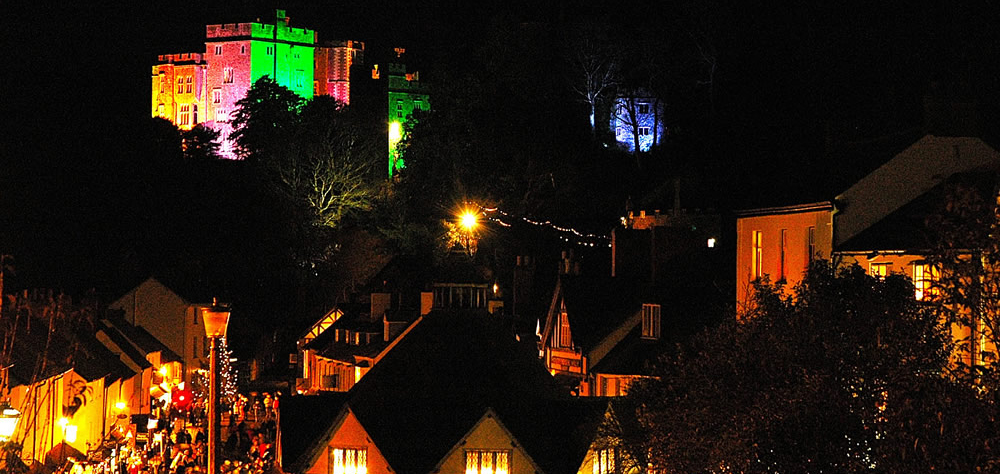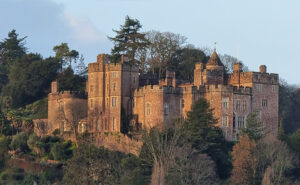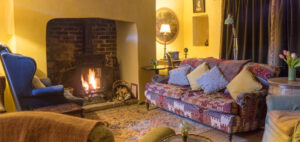The red stone castle is a magnificent tourist location in Dunster – located in the beautiful and incredibly conserved medieval village in Somerset. It is built on the peak of the conical hills called the Tor towards the edges of Exmoor. Apart from the exquisite interiors, this 13th-century gatehouse is surrounded by the natural scenic beauty especially the Mediterranian-inspired sub-tropical terraced garden towards the southern sloping hills.
From the motte and bailey castle of the medieval period to the country home of the Luttrell family, Dunster castle has witnessed several important historical milestones.
Early History (11th-12th Centuries)
Saxons invaded Dunster around 700 AD and later this village became the headquarters of an Anglo Saxon commander named Dun/Dunna. The site where Dunster Castle stands today originally had the West Saxon fortress managed by the last Saxon nobleman called Aelfric/Aluric. It was built on the hilltop to protect the village from invaders arriving in the region via sea route.
In 1066, Norman invaders defeated the English forces in the battle of Hastings. The Norman commander William de Mohun (Moion) le Viel (the elder) was granted fifty-five West Country manors including Dunster.
After becoming the Sheriff of Somerset in 1086, he built a motte and bailey style timber castle at the site of the former Anglo Saxon burgh. Normans scarped the apex point of the Tor to build the motte also called the Upper Ward and reformed the lower area beneath to form the bailey or the Lower Ward.
During this period the castle served as the caput of the Norman establishment in the region and defensive fortification for protecting Somerset from raiders coming through the coastal road and sea. In the early 12th century, William’s son who also had the same name William constructed the stone fortification encompassing the upper part of the motte.
The Anarchy and Seizure of Dunster Castle (1138)
During the period of Anarchy in England and Normandy, arousing severe conflict between the supporters of King Stephen of England and Queen Matilda of Normandy. At that time, Dunster was the Norman stronghold in the south-west and William’s elder son was an eminent supporter of Matilda. Stephen’s supporters built a siege castle in the village and ultimately succeeded in conquering the Dunster castle in 1138.
Despite the great conflict, William was able to acquire the castle back again. As a sign of reward, grateful Matilda declared William the Earl of Somerset. Though Henry II was able to capture the castle for a short span, it was finally inherited by William’s son, the third William in the de Mohun family. Later, he insisted on the tenants of the castle to contribute to repair and further construction as part of the feudal services.
In the 13th century, Reynold Mohun expanded the castle building the Lower Ward in stone including two towers a granary and a gatehouse. During this time, the Upper Ward had the chapel of Saint Stephen, a kitchen, pantry, bakehouse, a hall, and a knight hall defended by three towers.
The Era of the Luttrell Family (1376-1976)
After the death of John de Mohun in 1376, his wife Joan decided to sell the castle to Elizabeth Luttrell, the head of the rich Norman Luttrell family at that time. She sold the castle for 5000 marks agreeing to transfer the ownership post her death. Since Elizabeth died before Joan, Sir Hugh Luttrell acquired the castle after the death of Joan in 1404.
Remodelling and Expansion
Initially, Luttrell started the repair and expansion of the castle to transform it from a military base to a country home for the entire family. Major reforms executed during 1419-1424 include the construction of the Great Gatehouse, a defensive barbican, the new entrance made of imported Bristol red stone, Cornish stone tiles on the roof.
The Period of Civil Wars (15th-17th Century)
War of Roses
Sir James Luttrell, an eminent supporter of the House of Lancaster died during the Second Battle of St Albans in 1461. After the defeat of the Lancastrians in the battle, Luttrell family gave the possession of the castle to the Herberts but soon regained it back when Lancastrian Henry VII came to power 1485.
After inheriting the castle in 1571, George Luttrell decided to renovate it into a luxurious country home. He employed William Arnold, a highly-skilled architect of south-west England for the project in 1617. He reformed some parts of the castle into a Jacobean-style mansion having square towers, decorative plaster ceilings, etc.
English Civil War 1640
During the English Civil War of the 1640s, between the supporters of the then monarch King Charles I and the Parliament, Thomas Luttrell, the then owner and inhabitant of the castle supported the Parliament. Eyeing the chances Royalist attack, William Russell, the Duke of Bedford advised Thomas to strengthen the castle stronghold.
In 1642, the garrison of the castle, under the leadership of Thomas’ wife Jane Luttrell was able to resist the Royalist attack by Commander William Seymour, the Duke of Somerset. However, the family had to surrender to the Royalist and switch sides after the defeat in 1643. Following this event, Prince Charles (later Charles II) stayed in the castle in May 1645.
In 1645, the supporters of the Parliament seized the castle under the command of Colonel Robert Blake. Luttrell had to surrender to the forces and negotiate allowing the installation of Parliamentary garrison in the castle. During the aftermath of the end of the Second English Civil War in 1649, the Parliament decided to demolish the defence castles dominated by the Royalists.
George, the son of Thomas Luttrell, convinced the Parliamentary authorities to destroy only the defensive outer medieval walls leaving the inner parts of the castle. After the demolition of the walls, only the Great Gatehouse and the bases of the two towers in the Lower Ward of the medieval architecture are still present in the castle.
Modernization of the Dunster Castle
After marrying a rich Dorset heiress, Mary Tregonwell in 1680, Francis, the then heir executed a modernization project in some parts of the castle. One of the prettiest addition is the carved dark wood staircase with hunting scenes and acanthus leaves by the renowned carver of the time Edward Pearce.
Margaret Luttrell, the daughter of the then heir of the castle married Henry Fownes who adopted the Luttrell surname and moved to the castle in 1747. The couple conducted several reformative works in the castle. Henry raised the height of the ground level in the Lower Ward, built additional embellished towers beside the Great Gatehouse, and redesigned the interiors with modish wallpapers in Rococo style.
From Country House to Tourist Attraction
In 1816, John Luttrell decided to open the castle for the public and moved to London. In 1867, George Luttrell became the heir of the castle and started the most extensive modernization project. He hired a famous architect Anthony Salvin for the grand Victorian-style renovation of the castle.
The noteworthy addition to the castle was the massive underground reservoir with a capacity of 40,000 imperial gallons to start running water supply in the castle and the village. Besides this, Salvin also built a modern conservatory, gas plant for kitchen and heating, Victorian stylized windows, and large gathering hall. He also renovated the rooms to create a new Outer Hall, a billiard room, a drawing-room, a library, and a new gallery on the first floor.
Final Years of the Luttrell Family in the Castle
In 1910, Alexander Luttrell inherited the Dunster Castle but he decided to reside at the Court House in East Quantoxhead. However, his son Geoffrey reoccupied the empty castle in 1920 and renovated some rooms in the contemporary style. He also built a polo ground beside the castle.
During the World War II 1943-44, the castle was opened for injured soldiers, American and naval officers for treatment. When Geoffrey inherited the castle after Alexander’s death, it became impossible for him to pay the dues on inheritance taxes. He sold the castle with 8600 acres of surrounding land to Ashdale Property Company and continued to reside therein as a tenant.
In 1954, Geoffrey was able to purchase it again from the Crown Estate that had bought the castle earlier from the Ashdale Property Company.
Geoffrey’s son Colonel Walter Luttrell was the last member of the Luttrell family who owned the castle. He decided to live elsewhere and after his mother’s death choose to give away the castle. Ultimately, he transferred the ownership rights of the castle and its contents to the National Trust in 1976.
Modern Dunster Castle (1976-Present)
Dunster Castle is now one of the most famous tourist destinations in England. It is owned and regulated by the National Trust. It is a Scheduled Ancient Monument and Grade I listed building of the English Heritage. In 2008, the National Trust installed solar panels on the rooftop at the backside of the battlements for eco-friendly power supply in the entire castle. In April 2016, the authorities opened the 19th-century underground reservoir for public viewing.
Things to See at Dunster Castle
The castle has a fusion architecture with remains of the construction and reformation since the 13th century. It is a contemporary castle with most of the renovation work done during the 17th and 18th centuries by the Luttrell family when it was converted into a manor house.
The only existing portions of the medieval architecture include the Great Gatehouse built by Sir Hugh Luttrell in 1420 and the remains of the ruined towers in the Lower Ward. During the visit, you can still see the original 13th-century inner gateway with iron-bound oak doors constructed by Reynold de Mohun II.
The collection on exhibit for the public includes Vivian Ellis’ piano, artefacts such as Sir John Luttrell’s allegorical portrait, the story of Antony and Cleopatra depicted on a series of leatherette tapestries, etc. The leather painted wall hangings are the rarest and only existing collection of this type in the UK. The wooden staircase carved by Edward Pearce is a masterpiece of artwork.
When on a visit to the castle, watch out for the Justice Room that was used as the office room by George Luttrell and Victorian-style Drawing Room of the Luttrell family.

